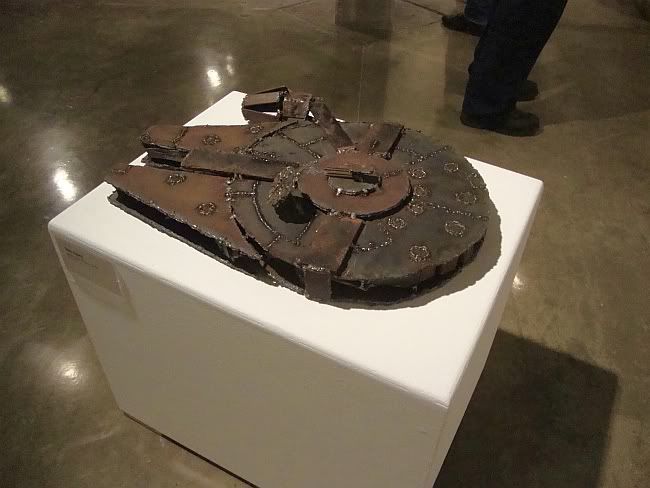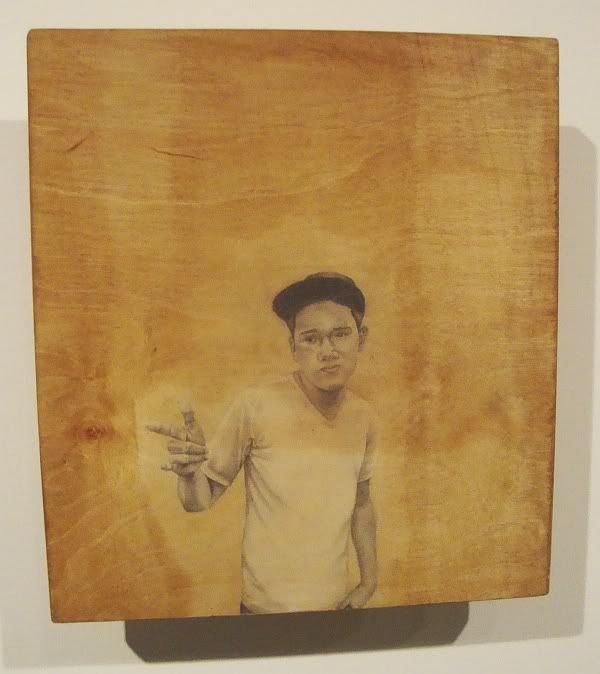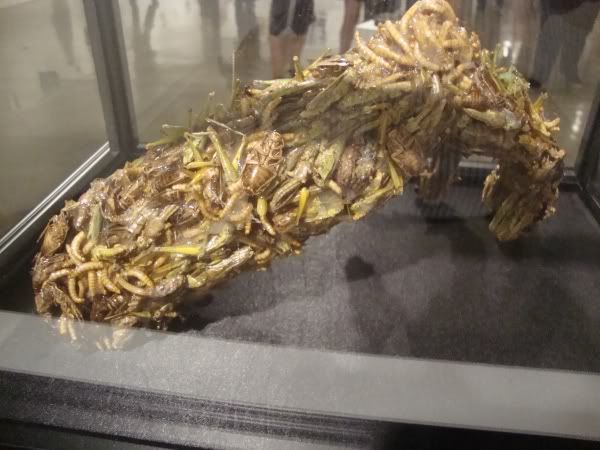When I was a boy, I was an avid, serious artist. I drew a lot, made super-8 movies (especially animated movies), painted, etc. I wasn't particularly brilliant--better than your average kid, I suppose. I had had good hand-eye coordination, and if I was drawing something in front of me--a still-life, a model, a photograph--I was not too bad. But like many young artists, there was something fundamentally student-ish about my work. The kinds of projects I undertook were juvenile. They often didn't feel "finished." Many of them--the best of them--felt like exercises rather than work that sprung from inside. They didn't need to exist.
All this is to preface Re: Generation, an art exhibit on view through June 26 at the CAMH. This is an exhibit by Houston area teens. Without knowing the origins of these pieces, they feel like they need to exist. That it was important for these students to produce them for their own purposes. And that is the first hurdle towards creating memorable art. I was very impressed and want to see more from these artists. I hope they all enter pieces into The Big Show at Lawndale. Below are a few of my favorites.

Riley Ogden, Millennium Falcon, scrap steel, 2010
Riley Ogden's scrap-metal sculpture reminds us that he is, well, a teenager. But what is beautiful about this is the combining of a well-known pop-culture image with such rough-hewn materials. He doesn't prettify it or hide the welds, and in doing so reminds us of the beauty of material. No doubt Ogden will go his own way, but if he became a new John Chamberlain or Mark "Scrap Daddy" Bradford, I wouldn't be surprised. (I wonder if Bradford offers internships?)

Jessica Vega, Social Identities II, graphite on wood, 2010
What appealed to me instantly about Jessica Vega's drawing was her choice to put it on wood.The wood, with it's own texture and coloring, renders the drawing, in a way, transparent. The grain of the wood is one image, and the drawing another image superimposed on top of it. You don't get that feeling with drawing on paper--the paper, even though it has a physical presence and physical characteristics that are very important to artists (paper's "tooth," for example), has a neutral presence to the viewer. Not so here. Wood is important. Vega may have used it because it is a construction material, and it seems to me that the drawing refers to the construction of social identity--an activity intensely important to teenagers.

Justine Ditto, Bathtub Conquest, soap sculptures, 2011
This one made me laugh. Soap sculpture has got to be one of the most debased media--I think of it as the kind of art you make untalented kids do in the kind of classes where you're basically just baby-sitting a bunch of middle-schoolers. And yet, Ditto has created the ideal soap sculptures--the perfect marriage of medium and content. What could be better than carving a flotilla of battleships? And the carving is beautiful. The takes a ridiculous medium and turns it into something clever and totally pleasing. A lot of art in the past 30 years or so has been about reclaiming media that had been relegated to being for amateur craftspeople or hobbyists--whether she intended to or not, Ditto has joined that august group of knitters and silhouette cutters, etc., in their art-historical project.

Justine Ditto, Bathtub Conquest detail, soap sculptures, 2011

Faith Pruneda, Ganglion, mixed media, 2010
It cracks me up that the title card for Faith Pruneda's Ganglion describes it as "mixed media." At least one medium she uses is a mass of dead bugs. At first blush, this piece is like a horror movie prop, but as I looked at it, the name Faith Pruneda seemed familiar. I checked into the Pan archives and found this piece:

Faith Pruneda, Luck be a Lady, mixed media with lady bugs
One piece involving bugs would be interesting. Two is an obsession. First an installation made of living ladybugs, then a horrific hand made of bug exoskeletons. Pruneda is really mining her media. Like Nausicaä, the young princess in Nausicaä of the Valley of the Wind, Pruneda appears to be way into insects. Nausicaä even has a dream of becoming pregnant with a bug (less creepy than it sounds in the context of the books), and that notion of transformation is clearly something to think about when you look at Ganglion. I am totally intrigued by this art--Pruneda is certainly one of the most creative young artists around.

Faith Pruneda, Ganglion, mixed media, 2010

Alyssa Hansen, Princess, digital photograph, 2010
This photo by Alyssa Hansen accompanied all the promotional material for this show, and it's easy to see why they picked it. Not only is it a very winning photograph, its subject perfectly reflects the show--a confident, idiosyncratic teenager, displaying a unique sense of style and creativity. It never occurred to me that anyone would think to tattoo the inside of her mouth. I have no idea if this tattoo is permanent or temporary. I like the notion of a crown tattooed in a secret place: one could construct a story of royalty--a princess--hiding among the people from those who would would harm her. This kind of story is almost as old as humanity, and variations of this story are universally popular among children and teenagers. Why? The reason is obvious--teenagers are changing, becoming who they will be, and feel that their identity is a secret--a secret that will amaze the world when it is finally revealed. This can be especially true of young artists. Spanish designer Mariscal once said (and I'm paraphrasing) that when he was a teenager, he felt like a Martian for wanting to do art for a living, and that it wasn't until he got to art school and was surrounded by a lot of other Martians did he finally feel at home. I wonder if the teenage artists in this show felt the same on opening night--finally meeting their fellow Martians. It must have been a glorious feeling.




No comments:
Post a Comment